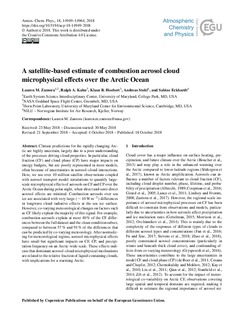| dc.contributor.author | Zamora, Lauren M | |
| dc.contributor.author | Kahn, Ralph A. | |
| dc.contributor.author | Huebert, Klaus B | |
| dc.contributor.author | Stohl, Andreas | |
| dc.contributor.author | Eckhardt, Sabine | |
| dc.date.accessioned | 2019-01-04T13:30:54Z | |
| dc.date.available | 2019-01-04T13:30:54Z | |
| dc.date.created | 2018-12-09T06:09:03Z | |
| dc.date.issued | 2018 | |
| dc.identifier.citation | Atmospheric Chemistry and Physics. 2018, 18 (20), 14950-14964. | nb_NO |
| dc.identifier.issn | 1680-7316 | |
| dc.identifier.uri | http://hdl.handle.net/11250/2579246 | |
| dc.description.abstract | Climate predictions for the rapidly changing Arctic are highly uncertain, largely due to a poor understanding of the processes driving cloud properties. In particular, cloud fraction (CF) and cloud phase (CP) have major impacts on energy budgets, but are poorly represented in most models, often because of uncertainties in aerosol–cloud interactions. Here, we use over 10 million satellite observations coupled with aerosol transport model simulations to quantify large-scale microphysical effects of aerosols on CF and CP over the Arctic Ocean during polar night, when direct and semi-direct aerosol effects are minimal. Combustion aerosols over sea ice are associated with very large (∼ 10Wm−2) differences in longwave cloud radiative effects at the sea ice surface. However, co-varying meteorological changes on factors such as CF likely explain the majority of this signal. For example, combustion aerosols explain at most 40% of the CF differences between the full dataset and the clean-condition subset, compared to between 57% and 91% of the differences that can be predicted by co-varying meteorology. After normalizing for meteorological regime, aerosol microphysical effects have small but significant impacts on CF, CP, and precipitation frequency on an Arctic-wide scale. These effects indicate that dominant aerosol–cloud microphysical mechanisms are related to the relative fraction of liquid-containing clouds, with implications for a warming Arctic. | nb_NO |
| dc.language.iso | eng | nb_NO |
| dc.rights | Navngivelse 4.0 Internasjonal | * |
| dc.rights.uri | http://creativecommons.org/licenses/by/4.0/deed.no | * |
| dc.title | A satellite-based estimate of combustion aerosol cloud microphysical effects over the Arctic Ocean | nb_NO |
| dc.type | Journal article | nb_NO |
| dc.type | Peer reviewed | nb_NO |
| dc.description.version | publishedVersion | nb_NO |
| dc.rights.holder | © Author(s) 2018. | nb_NO |
| dc.source.pagenumber | 14950-14964 | nb_NO |
| dc.source.volume | 18 | nb_NO |
| dc.source.journal | Atmospheric Chemistry and Physics | nb_NO |
| dc.source.issue | 20 | nb_NO |
| dc.identifier.doi | 10.5194/acp-18-14949-2018 | |
| dc.identifier.cristin | 1640707 | |
| dc.relation.project | NILU: 111108 | nb_NO |
| dc.relation.project | NILU: 114012 | nb_NO |
| cristin.unitcode | 7460,57,0,0 | |
| cristin.unitname | Atmosfære og klima | |
| cristin.ispublished | true | |
| cristin.fulltext | original | |
| cristin.qualitycode | 2 | |

